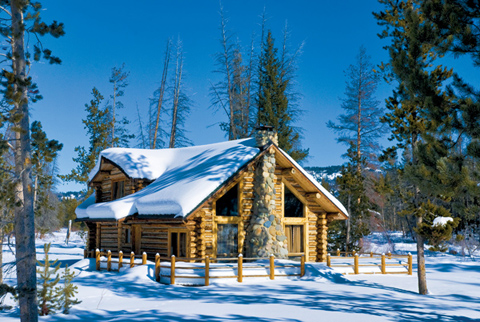Seasons change. Log and timber home owners are wise to heed the advice that seems to be everywhere. Winterize to protect your investment, prevent larger maintenance issues, and ensure the best of experiences regardless of temperature, snow, ice, and howling winds.
Basic prevention makes all the difference. Begin with a general inspection, much of which can be completed by homeowners themselves. Service providers are also available to make light work of seasonal chores.
“The first thing to do is to inspect the stain and sealant and evaluate what condition it is in,” advises Greg Crider, a dealer for Honest Abe Log Homes and owner of Renew Services in Shippensburg, Pennsylvania. “Does it show excessive wear or flaking? How about the caulking and chinking? The change in temperature will be most noticed here, as wood expands and contracts when exposed to hot and cold temperature swings.”

Temperature changes may cause caulking and chinking to pull away from one or both edges of exterior logs, says Crider, If it has pulled away, the material should be removed and replaced to prevent the joint from becoming a dam where water may build up. “If left unaddressed this is a problem you will notice in the form of a rotting log,” he adds. “That is much harder to repair than a simple check or caulk joint.”
According to Crider, the most commonly overlooked log or timber home maintenance item is keeping the exterior finish clean. Dirt holds moisture, which in turn breaks down stain, caulk, and chinking. “The finish on your home is like the finish on your car,” he reasons. “Keep it clean, and it will look better and last longer.” Minor repairs to sealing and chinking can be accomplished easily, and getting started early helps. Some materials need moderate temperatures to cure properly.
Adequate weatherization of windows and doors, particularly maintaining good seals during cold weather, will prevent draftiness and keep heating bills down. Weather stripping is inexpensive and easy to install. Of course, the installation of quality windows and doors limits the need for additional or unexpected maintenance. “Fall and winter mean leaves, and plenty of them,” relates Tony Huddleston, vice president of sales and marketing for Perma-Chink Systems, Inc. “You will certainly need to clean out your gutters and make sure that the drainage area around the downspout is functioning properly as well. The roof area should be checked for any leaks around the flashing at the chimney and around the vents for the heating or sewer system. While inspecting the roof area, it’s important to check for any holes or access spots where squirrels, raccoons, or bats can enter your home and make themselves a vacation home for the winter. Clear away all debris from the foundation of the house.”
The safe operation of fireplaces, home heating, and ventilation systems is a prerequisite for enjoying log and timber homes during the winter season. Brad Neu of Montana Log Homes suggests having the furnace or other heating apparatus inspected annually prior to the onset of winter and, in areas of high snow accumulation or precipitation, keeping exterior equipment some distance from the side of the structure so water and snow do not pile up and interfere with operation.

“Check chimneys when you are coming into the season of high use,” offers Neu. “Chimney fires can happen, and this definitely needs to be on the to-do list. Fill propane or heating oil tanks before the high-use season comes, and if you have a wood-burning stove or fireplace, get a supply of wood in early because it can be hard to get in winter.”
To prevent pipes from bursting during extreme cold, exterior water lines should be drained. Even interior water lines adjacent to outside walls may be susceptible to freezing. They should be insulated whenever and wherever possible. Outdoor faucets should be dry, and garden hoses should be disconnected. Many external water sources are supplied by interior valves, and these should be closed for the season.
Owners of log and timber homes should inspect attics, basements, and crawl spaces for any loose insulation, debris, cracks, or separations in exterior walls and joints. Streaks of sunlight indicate an issue that needs to be addressed in an area that should be sealed tightly. Proper insulation saves money and makes a home cozy during the winter. Assess the overall quality and adequacy of insulation regularly.
“Periodic maintenance is way less expensive than waiting for something to happen,” comments Neu, “especially when winter weather sets in. Routine maintenance is simpler too.”
Taking a few reasonable steps can make all the difference in passing the winter in the carefree comfort of a log and timber home.

